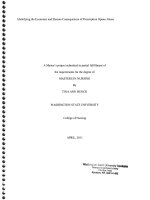Simplifying the Estimation of Difference in Differences treatment effects with Stata
Bạn đang xem bản rút gọn của tài liệu. Xem và tải ngay bản đầy đủ của tài liệu tại đây (247.03 KB, 12 trang )
<span class='text_page_counter'>(1)</span><div class='page_container' data-page=1>
Munich Personal RePEc Archive
<b>Simplifying the estimation of difference</b>
<b>in differences treatment effects with</b>
<b>Stata</b>
Villa, Juan M.
Brooks World Poverty Institute, University of Manchester
November 2012
</div>
<span class='text_page_counter'>(2)</span><div class='page_container' data-page=2>
<b>Simplifying the Estimation of Difference in Differences Treatment Effects with Stata</b>
*
Juan M. Villa
Brooks World Poverty Institute
University of Manchester
Manchester, UK.
*** DRAFT VERSION ***
<b>Abstract. </b>
This paper explains the insights of the Stata's user written command
diff
for
the estimation of Difference in Differences treatment effects (DID). The options and the
formulas are detailed for the single DID, Kernel Propensity Score DID, Quantile DID and the
balancing properties . An example of the features of
diff
is presented by using the dataset
from Card and Krueger (1994).
<b>Keywords:</b>
Difference in differences, causal inference, kernel propensity score, quantile
treatment effects, quasi-experiments.
<b>1. Introduction </b>
Difference in Differences treatment effects (DID) have been widely used when the
evaluation of a given intervention entails the collection of panel data or repeated cross
sections. DID integrates the advances of the fixed effects estimators with the causal
inference analysis when unobserved events or characteristics confound the interpretations
(Angrist and Pischke, 2008).
Despite the existence of other plausible methods based on the availability of observational
data for quasi-experimental causal inference -i.e. matching methods, instrumental variable,
regression discontinuity-, DID estimations offer an alternative reaching the
unconfoundedness by controlling for unobserved characteristics and combining it with
observed or complementary information. Additionally, the DID is a flexible form of causal
inference because it can be combined with some other procedures, such as the Kernel
*
<sub> A previous version of this paper was presented at the 2012 UK Stata Users Group Meeting in London, UK. </sub>
</div>
<span class='text_page_counter'>(3)</span><div class='page_container' data-page=3>
Propensity Score (Heckman et al., 1997, 1998) and the quintile regression (Meyer et al.,
1995).
In this paper, the Stata's command
diff
is explained and some details on its
implementation are given by using the datasets from the Card and Krueger (1994) article
on the effects of the increase in the minimum wage. Similarly, it is explain how the
balancing properties can be tested when observational data is provided.
In the next section the equations behind the estimation of the DID are explained along with
the features of the
diff
command. In the third section and example is provided and, in the
fourth section, the balancing properties are tested with the options that can be specified
with the command.
<b>2. </b>
<b>diff</b>
<b><sub> syntax and equations </sub></b>
diff
can be installed or updated from the SSC archive by running the command:
ssc install diff, replace
The
diff
syntax is detailed as follows:
diff
<i>outcome_var</i>
[
<i>if</i>
] [
<i>in</i>
] [
<i>weight</i>
] ,[
<i>options</i>
]
The command requests the specification of the outcome variable (
outcome_var
) and
allows the use of weights, except for some options. The initial required option is the
period(
<i>varname</i>
)
, which contains a dummy variable indicating the baseline (
period==0
)
and a follow-up (
period==1
) periods. Additionally, the option
treated(
<i>varname</i>
)
, is
need, containing a dummy variable with the indicator of the control (
treated==0
) and
treated (
treated==1
) individuals.
For the individual
, this initial setting performs the following linear regression:
The estimated coefficients have the following interpretation:
: Is the mean outcome for the control group on the baseline.
: Is the mean outcome for the control group in the follow-up.
: Is the single difference between treated and control groups on the baseline.
<sub> </sub>
: Is the mean outcome for the treated group on the baseline.
</div>
<span class='text_page_counter'>(4)</span><div class='page_container' data-page=4>
: Is the DID or impact.
The
diff
command arranges these coefficients in the output table. The number of
observations, r-squared, standard errors, t-statistic -or the z-stat when standard errors are
bootstrapped- and the p-value are also reported:
Number of observations in the DIFF-IN-DIFF: #
Baseline Follow-up
Control: # #
Treated: # #
R-square: 0.0
DIFFERENCE IN DIFFERENCES ESTIMATION
--- --- BASE LINE --- --- FOLLOW UP --- ---
Outcome Variable | Control | Treated | Diff(BL) | Control | Treated | Diff(FU) | DIFF-IN-DIFF
---+---+---+---+---+---+---+---
<i>outcome_variable</i> |
Std. Error | | | | | | |
t/z | | | | | | |
P>|t/z| | | | | | | |
---
* Means and Standard Errors are estimated by linear regression
**Inference: *** p<0.01; ** p<0.05; * p<0.1
<b>2.1 Options </b>
cov(
<i>varlist</i>
)
- Specifies the pre-treatment covariates of the model. These variables are
also known as controls or observable characteristics. If we denote
<sub> </sub>
as the
th covariate,
diff
runs the following regression with this option:
The coefficients
are not reported in the output table. However, it is possible to request
them if option
report
is specified.
kernel
- Performs the Kernel-based Propensity Score DID. At a first stage, this option runs
a
probit
model -or
logit
if this option is selected- of the
treated(
<i>varname</i>
)
on the
cov(
<i>varlist</i>
)
. It generates the variables _
weights
that contains the weights derived
from the kernel density function and
_ps
when the Propensity Score is not specified in
pscore(
<i>varname</i>
)
. This option requires the
id(
<i>varname</i>
)
of each individual, hence it is
not compatible with repeated cross section. It also allows the estimation of the DID on the
common support by specifying the option
support
.
In a second stage,
diff
runs a regression applying the Stata's average weights option
[av=_weights]
, obtained from the propensity score:
</div>
<span class='text_page_counter'>(5)</span><div class='page_container' data-page=5>
Option
kernel
can be customized by selection the bandwidth,
bw(#)
and the kernel type,
ktype(
<i>kernel</i>
)
, according to the Stata's
kdensity
choices. Finally, the first stage is
explicitly showed if
report
is specified.
qdid(quantile)
- Performs the Quantile Difference in Differences estimation at the
specified quantile from 0.1 to 0.9 (quantile 0.5 performs the QDID at the medeian). It may
be combined with
kernel
and
cov(
<i>varlist</i>
)
options.
qdid(quantile)
does not
support weights nor robust standard errors. This option uses Stata's
qreg
and
bsqreg
for bootstrapped standard errors. See Angrist and Pischke (2008) for detailed information
on Quantile Treatment Effects and Meyer et al. (1995) for a illustrative example.
cluster(
<i>varname</i>
)
- Calculates clustered standard errors by
<i>varname</i>
.
robust
- Calculates robust Std. Errors.
bs
- Performs a Bootstrap estimation of coefficients and standard errors.
reps(
<i>int</i>
)
specifies the number of repetitions when the bs is selected. The default are 50 repetitions.
nostar
- Removes the inference stars from the p-values.
<b>2.2 Option: balancing test </b>
test
- Performs a balancing t-test of difference in means of the specified covariates
between the control and treated groups in
period == 0
. The option test combined with
kernel
performs the balancing t-test with the weighted covariates. Stata's
ttest
command is used to estimate the t-statistics and standard errors.
For each variable in
cov(
<i>varlist</i>
), test
option runs the command:
ttest cov(
<i>varname</i>
) if period == 0, by(treated)
When combined with
kernel
, the differences, t-statistics and standard errors are
generated with linear regression.
<b>3. Example </b>
diff
offers an example with the dataset from Card and Krueger (1994). It can be
downloaded into the working directory by running
net get diff
and then,
use
</div>
<span class='text_page_counter'>(6)</span><div class='page_container' data-page=6>
The description of the variables in the dataset are is the following:
Contains data from cardkrueger1994.dta
obs: 820 Dataset from Card&Krueger (1994)
vars: 8
size: 18,860 (99.9% of memory free)
---
storage display value
variable name type format label variable label
---
id int %8.0g Store ID
t byte %8.0g Feb. 1992 = 0; Nov. 1992 = 1
treated long %8.0g treated New Jersey = 1; Pennsylvania = 0
fte float %9.0g Output: Full Time Employment
bk byte %8.0g Burger King == 1
kfc byte %8.0g Kentuky Fried Chiken == 1
roys byte %8.0g Roy Rogers == 1
wendys byte %8.0g Wendy's == 1
---
Sorted by: id t
With 820 observations, the number of individuals or stores are 331 and 79 in the treated
and control groups, respectively. The outcome variable is fte, while some covariates are
defined as dummy variable indicating whether the observation belongs to a given fast food
restaurant. The basic statistic are show as follows:
Variable | Obs Mean Std. Dev. Min Max
---+---
id | 820 246.5073 148.1413 1 522
t | 820 .5 .5003052 0 1
treated | 820 .8073171 .3946469 0 1
fte | 801 17.59457 9.022517 0 80
bk | 820 .4170732 .4933761 0 1
kfc | 820 .195122 .3965364 0 1
roys | 820 .2414634 .4282318 0 1
wendys | 820 .1463415 .3536639 0 1
---+---
<b>3.1 DID with no covariates </b>
diff fte, t(treated) p(t)
The output table of this initial setting is:
Number of observations in the DIFF-IN-DIFF: 801
Baseline Follow-up
Control: 78 77 155
Treated: 326 320 646
404 397
R-square: 0.00805
DIFFERENCE IN DIFFERENCES ESTIMATION
</div>
<span class='text_page_counter'>(7)</span><div class='page_container' data-page=7>
---
* Means and Standard Errors are estimated by linear regression
**Inference: *** p<0.01; ** p<0.05; * p<0.1
The baseline information contains the columns with the mean outcome for each group and
its difference (-2.88 in this case). These estimators are presented along with standard
errors, t-statistics and p-values. The same information is showed for the baseline (with a
difference of 0.03). The last column is the difference in differences, that is, 0.03 - (-2.88) =
2.94. The p-value is accompanied by a star interpreted as the statistical inference at
different significant levels.
Alternatively, bootstrapped standard errors can be requested by adding the potion
bs
:
diff fte, t(treated) p(t) bs rep(50)
Bootstrap replications (50)
----+--- 1 ---+--- 2 ---+--- 3 ---+--- 4 ---+--- 5
... 50
Number of observations in the DIFF-IN-DIFF: 801
Baseline Follow-up
Control: 78 77 155
Treated: 326 320 646
404 397
R-square: 0.00805
Bootstrapped Standard Errors
DIFFERENCE IN DIFFERENCES ESTIMATION
--- --- BASE LINE --- --- FOLLOW UP --- ---
Outcome Variable | Control | Treated | Diff(BL) | Control | Treated | Diff(FU) | DIFF-IN-DIFF
---+---+---+---+---+---+---+---
fte | 19.949 | 17.065 | -2.884 | 17.542 | 17.573 | 0.030 | 2.914
Std. Error | 1.330 | 0.494 | 1.381 | 0.830 | 0.477 | 0.920 | 1.792
z | 15.00 | 14.12 | -2.09 | 17.05 | 20.76 | 0.28 | 1.63
P>|z| | 0.000 | 0.000 | 0.037** | 0.000 | 0.000 | 0.974 | 0.104
---
* Means and Standard Errors are estimated by linear regression
**Inference: *** p<0.01; ** p<0.05; * p<0.1
<b>3.2 DID with covariates </b>
diff fte, t(treated) p(t) cov(bk kfc roys)
DIFFERENCE-IN-DIFFERENCES WITH COVARIATES
Number of observations in the DIFF-IN-DIFF: 801
Baseline Follow-up
Control: 78 77 155
Treated: 326 320 646
404 397
R-square: 0.18784
DIFFERENCE IN DIFFERENCES ESTIMATION
</div>
<span class='text_page_counter'>(8)</span><div class='page_container' data-page=8>
fte | 21.161 | 18.837 | -2.324 | 18.758 | 19.369 | 0.611 | 2.935
Std. Error | 1.142 | 0.851 | 1.031 | 1.158 | 0.853 | 1.037 | 1.460
t | 18.53 | 18.43 | -2.25 | 19.09 | 19.87 | 0.51 | 2.01
P>|t| | 0.000 | 0.000 | 0.024** | 0.000 | 0.000 | 0.556 | 0.045**
---
* Means and Standard Errors are estimated by linear regression
**Inference: *** p<0.01; ** p<0.05; * p<0.1
Option
report
allows the output table of the coefficients from the
cov(
<i>varlist</i>
)
:
Covariates and Coefficients:
---
Variable(s) | Coeff. | Std. Err. | t | P>|t|
---+---+---+---+---
bk | 0.917 | 0.889 | 1.032 | 0.303
kfc | -9.205 | 1.006 | -9.154 | 0.000
roys | -0.897 | 0.967 | -0.927 | 0.354
---
<b>3.3 Kernel Propensity Score DID </b>
The Kernel Propensity Score DID can be estimated on the common support of the
propensity score. I you have previously estimated the propensity score you can provide it
with the option
pscore(varname)
. The basic syntax is:
diff fte, t(treated) p(t) cov(bk kfc roys) kernel id(id)
The full options are:
diff fte, t(treated) p(t) cov(bk kfc roys) kernel id(id) report
With the following output table:
KERNEL PROPENSITY SCORE DIFFERENCE-IN-DIFFERENCES
Report - Propensity score estimation:
Iteration 0: log likelihood = -198.21978
Iteration 1: log likelihood = -196.7657
Iteration 2: log likelihood = -196.7636
Probit regression Number of obs = 404
LR chi2(3) = 2.91
Prob > chi2 = 0.4053
Log likelihood = -196.7636 Pseudo R2 = 0.0073
---
treated | Coef. Std. Err. z P>|z| [95% Conf. Interval]
---+---
bk | .1812529 .2090916 0.87 0.386 -.2285591 .5910649
kfc | .3888298 .246799 1.58 0.115 -.0948873 .8725469
roys | .2997977 .2318227 1.29 0.196 -.1545664 .7541618
_cons | .6476036 .1777446 3.64 0.000 .2992305 .9959767
---
Number of observations in the DIFF-IN-DIFF: 800
</div>
<span class='text_page_counter'>(9)</span><div class='page_container' data-page=9>
Control: 78 76 154
Treated: 326 320 646
404 396
R-square: 0.02819
DIFFERENCE IN DIFFERENCES ESTIMATION
--- --- BASE LINE --- --- FOLLOW UP --- ---
Outcome Variable | Control | Treated | Diff(BL) | Control | Treated | Diff(FU) | DIFF-IN-DIFF
---+---+---+---+---+---+---+---
fte | 21.656 | 17.065 | -4.591 | 18.914 | 17.573 | -1.341 | 3.250
Std. Error | 0.572 | 1.093 | 1.234 | 0.576 | 1.103 | 1.245 | 1.752
t | 37.88 | 17.46 | -3.72 | 16.89 | 17.27 | -1.98 | 1.85
P>|t| | 0.000 | 0.000 | 0.000*** | 0.000 | 0.000 | 0.282 | 0.064*
---
* Means and Standard Errors are estimated by linear regression
**Inference: *** p<0.01; ** p<0.05; * p<0.1
<b>3.4 Quantile DID </b>
The Quantile DID is obtained when specifying the option
qdid(quantile)
. For example,
estimating the treatment effects on the median requires the following syntax:
diff fte, t(treated) p(t) qdid(0.50)
It may be combined with covariates:
diff fte, t(treated) p(t) qdid(0.50) cov(bk kfc roys)
With the following output:
QUANTILE DIFFERENCE-IN-DIFFERENCES WITH COVARIATES
Number of observations in the DIFF-IN-DIFF: 801
Baseline Follow-up
Control: 78 77 155
Treated: 326 320 646
404 397
R-square: 0.14861
DIFFERENCE IN DIFFERENCES ESTIMATION
--- --- BASE LINE --- --- FOLLOW UP --- ---
Outcome Variable | Control | treated | Diff(BL) | Control | treated | Diff(FU) | DIFF-IN-DIFF
---+---+---+---+---+---+---+---
fte | 17.750 | 17.250 | -0.500 | 17.750 | 17.750 | -0.000 | 0.500
Std. Error | 1.124 | 0.835 | 1.013 | 1.132 | 0.840 | 1.007 | 1.426
t | 15.79 | 17.15 | -0.49 | 17.75 | 17.85 | -0.00 | 0.35
P>|t| | 0.000 | 0.000 | 0.622 | 0.000 | 0.000 | 1.000 | 0.726
---
* Values are estimated at the .5 quantile
**Inference: *** p<0.01; ** p<0.05; * p<0.1
Quantile DID is combinable with the option
kernel
:
diff fte, t(treated) p(t) qdid(0.50) cov(bk kfc roys) kernel id(id)
report
</div>
<span class='text_page_counter'>(10)</span><div class='page_container' data-page=10>
Report - Propensity score estimation:
Iteration 0: log likelihood = -198.21978
Iteration 1: log likelihood = -196.7657
Iteration 2: log likelihood = -196.7636
Probit regression Number of obs = 404
LR chi2(3) = 2.91
Prob > chi2 = 0.4053
Log likelihood = -196.7636 Pseudo R2 = 0.0073
---
treated | Coef. Std. Err. z P>|z| [95% Conf. Interval]
---+---
bk | .1812529 .2090916 0.87 0.386 -.2285591 .5910649
kfc | .3888298 .246799 1.58 0.115 -.0948873 .8725469
roys | .2997977 .2318227 1.29 0.196 -.1545664 .7541618
_cons | .6476036 .1777446 3.64 0.000 .2992305 .9959767
---
Number of observations in the DIFF-IN-DIFF: 800
Baseline Follow-up
Control: 78 76 154
Treated: 326 320 646
404 396
R-square: 0.00477
DIFFERENCE IN DIFFERENCES ESTIMATION
--- --- BASE LINE --- --- FOLLOW UP --- ---
Outcome Variable | Control | Treated | Diff(BL) | Control | Treated | Diff(FU) | DIFF-IN-DIFF
---+---+---+---+---+---+---+---
fte | 18.500 | 16.000 | -2.500 | 18.500 | 17.500 | -1.000 | 1.500
Std. Error | 1.578 | 0.732 | 1.739 | 1.614 | 0.727 | 1.770 | 2.482
t | 11.72 | 15.08 | -1.44 | 18.50 | 18.06 | -1.65 | 0.60
P>|t| | 0.000 | 0.000 | 0.151 | 0.000 | 0.000 | 0.572 | 0.546
---
* Values are estimated at the .5 quantile
**Inference: *** p<0.01; ** p<0.05; * p<0.1
<b>3.5 Balancing test </b>
The balancing test is obtained only on the baseline. The syntax is similar to the one
presented before, except for the supply of option
test
.
diff fte, t(treated) p(t) cov(bk kfc roys wendys) test
TWO-SAMPLE T TEST
Number of observations (baseline): 404
Baseline Follow-up
Control: 78 - 78
Treated: 326 - 326
404 -
t-test at period = 0:
</div>
<span class='text_page_counter'>(11)</span><div class='page_container' data-page=11>
wendys | 0.190 | 0.136 | -0.054 | 1.22 | 0.2241
---
*** p<0.01; ** p<0.05; * p<0.1
When combined with option
kernel
, the covariates are weighted and the differences
obtained by linear regression:
diff fte, t(treated) p(t) cov(bk kfc roys wendys) test id(id) kernel
TWO-SAMPLE T TEST
Number of observations (baseline): 404
Baseline Follow-up
Control: 78 - 78
Treated: 326 - 326
404 -
t-test at period = 0:
---
Weighted Variable(s) | Mean Control | Mean Treated | Diff. | |t| | Pr(|T|>|t|)
---+---+---+---+---+---
fte | 21.656 | 17.065 | -4.591 | 3.22 | 0.0014***
bk | 0.618 | 0.408 | -0.210 | 3.55 | 0.0004***
kfc | 0.104 | 0.209 | 0.104 | 2.60 | 0.0097***
roys | 0.183 | 0.252 | 0.068 | 1.42 | 0.1570
wendys | 0.095 | 0.132 | 0.037 | 1.01 | 0.3123
---
*** p<0.01; ** p<0.05; * p<0.1
Attention: option kernel weighs variables in cov(varlist)
Means and t-test are estimated by linear regression
<b>4. Saved results </b>
diff
saves in the memory each number of thee output table as return-type scalars:
r(mean_c0):
mean of
<i>output_var</i>
of the control group in
period == 0
.
r(mean_t0)
: mean of
<i>output_var</i>
of the treated group in
period == 0.
r(diff0)
:
difference of the mean of
<i>output_var</i>
between treated and control groups
in
period t=0
.
r(mean_c1)
: mean of
<i>output_var</i>
of the control group in
period == 1
.
r(mean_t1):
mean of
<i>output_var</i>
of the treated group in
period == 1
.
r(diff1)
: difference of the mean of
<i>output_var</i>
between treated and control groups
in
period == 1
.
r(diffdiff)
: DID - Treatment Effect.
r(se_c0)
: Standard Error of the mean of
<i>output_var</i>
of the control group in
period
== 0.
r(se_t0)
: Standard Error of the mean of
<i>output_var</i>
of the treated group in
period
==0
.
r(se_d0)
:
Standard Error of the difference of
<i><sub>output_var</sub></i>
between the treated and
</div>
<span class='text_page_counter'>(12)</span><div class='page_container' data-page=12>
r(se_c1)
:
Standard Error of the mean of
<i>output_var</i>
of the control group in
period
==1
.
r(se_t1):
Standard Error of the mean of
<i>output_var</i>
of the treated group in
period
==1.
r(se_d1):
Standard Error of the difference of
<i>output_var</i>
between the treated and
control groups in
period == 0
.
r(se_dd)
:
Standard Error of the difference in difference.
<b>5. Acknowledgements </b>
I thank David Card for his useful suggestions on DID and Kit Baum for his valuable
comments on the Stata's ado file. I also thank the comments from the attendees at the 2012
UK Stata Users Meeting Group in London, UK.
<b>6. References </b>
Angrist, J.D., Pischke, J.-
S., 2008. Mostly Harmless Econometrics: An Empiricist’s
Companion. Princeton University Press.
Card, D., Krueger, A.B., 1994. Minimum Wages and Employment: A Case Study of the
Fast-Food Industry in New Jersey and Pennsylvania. American Economic Review 84,
772
–
93.
Heckman, J.J., Ichimura, H., Todd, P., 1998. Matching as an Econometric Evaluation
Estimator. The Review of Economic Studies 65, 261
–
294.
Heckman, J.J., Ichimura, H., Todd, P.E., 1997. Matching as an Econometric Evaluation
Estimator: Evidence from Evaluating a Job Training Programme. The Review of
Economic Studies 64, 605
–
654.
Meyer, B.D., Viscusi, W.K., Durbin, D.L., 1995. Workers’ Compensation and Injury Duration:
</div>
<!--links-->









